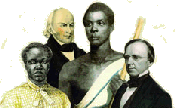Black History
When I was in school there was no Black History so when I compiled the material for A Year with American Saints and included 52 African Americans, I learned a lot. I didn’t read all of Theodore Dwight Weld’s classic, American Slavery As It Is, but enough to get the picture. And since then I’ve read some other slave narratives as well. Sobering.
And now I’m embarked on a larger project, a biography of James W. C, Pennington, a fugitive slave who became a leading spokesman for African Americans between 1840 and 1860. Since he spent the first part of those years in Hartford, I’ve moved to Hartford for a couple of weeks to do some research and last week I spent time at the Connecticut Historical Society Library. Yesterday I made a discovery that brought the situation of race in America home in a whole new way.
Somehow I discovered that there were Hartford City Registers published annually in the 19th century and the Connecticut Historical Society has them on hand. I asked for the series between 1840 and 1850 and sat down to look at them.
James Pennington moved to Hartford in 1840. The 1840 Register, not surprisingly, doesn’t list him. But neither does the 1841 Register. In 1842, however, the Register took a progressive step and added a listing of “Colored Persons” at the end. Pennington was listed there. I looked at the other names on the list and then checked the 1840 and 1841 Registers again. None of the Colored Persons listed separately in 1842 is in the previous Registers. They didn’t exist! And this is not in the south; this is in Hartford, a center of progressive New England thought. And granted, the “Colored” population of Hartford in those days was not large, but they did exist! And they were part of the population, not a separate species.
I went to services at the Cathedral the next day. We’ve come a long way. The presiding priest was a Black woman; acolytes choir and congregation were a representative cross-section of the city. But have we as a society really overcome the legacy of a day when one segment of the population could imagine that another segment didn’t exist?
[The picture shows some of those involved in the Amistad incident. The figure top right is Cinque, leader of the mutiny that took over the Amistad. He and the other mutineers were held in Hartford pending their trial and James Pennington became involved in their case – an event that helped make slavery visible in Connecticut.]

 Christopher L. Webber
Christopher L. Webber